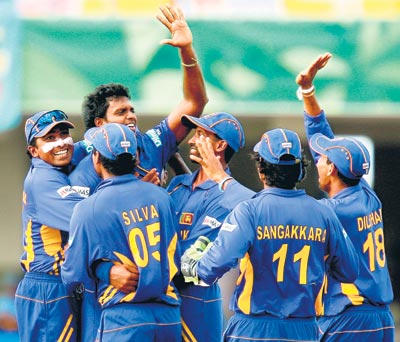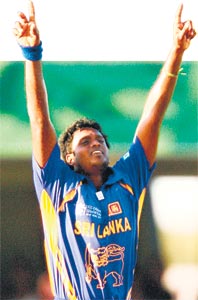
Team spirit and confidence high now
The week began quietly enough with the encounter against the West Indies. It was a crucial game in more ways than one. The West Indies, while being the hosts were fighting to get through to the semi finals. It was our first game since the loss to South Africa and we were keen to get back to a winning streak-and a loss would have made entry to the semis much more difficult.
Mahela was unlucky with the toss and we were asked to bat. The wicket was difficult to adjust to initially and I was determined that we should make the most of having first lease of the wicket at the Providence Stadium in Guyana. I decided to take very few risks and watch the bowling carefully at least during the first fifteen overs, especially after losing Upul and Sanga early. That was the reason for my slow scoring at the beginning of the innings and our score of 50 for 2 at the end of 15 overs. When Mahela came out to bat with the score at 35 for 2, we had a little chat about how we would approach the next few overs. We decided that Mahela should bat without taking any risks at all and try to bat as long as possible while I would be on the lookout for runs. That strategy paid off. I was able to shift from cautious to carefree and Mahela at the other end regained the form that that had been eluding him. I would rate the 115 I scored as one of my best because of the context of the game: a win was vital for us to proceed to the semis, the wicket was difficult and we were still smarting from the defeat to South Africa. A target of 303 was never going to be easy although the Windies did try to make a match of it, at least initially when Chanderpaul and Sarwan put on 92 runs for the fourth wicket. For me, a turning point in the game was Sanga’s brilliant stumping of Lara. We always planned for Sanga to stand up when Vaasey was bowling so that the batsman would have less freedom to go for his shots but Sanga’s split second glove-work was sensational. As Lara is the kind of batsman who could win a match single-handed, it could be said that stumpings too–and not only catches-win matches! Three days later after a short flight to Antigua we fronted up to the Englishmen. They too-much like the West Indies-were desperate for a win. The venue was the Sir Vivian Richards Stadium, yet another brand new facility purpose built for the World Cup. As a result, the nature of the wicket was again unknown.
Mahela’s losing habit with the toss continued and we were asked to bat first but we had decided that had we won the toss, we would have batted anyway. We heard that experts were predicting a wicket which would yield 275 runs or more. For our purposes, we thought that the wicket was dry with some early morning moisture in it. Therefore, we never thought of a target in excess of 250. Out in the middle, Upul and I realised that batting was not as easy as had been suggested. In addition to the moisture, the wicket was also two-paced with some deliveries rising sharply and others keeping low. For the English pace bowlers, it was a great opportunity to grab quick wickets instead of leaking runs in the power plays. Therefore, we decided that one of the top four batsmen-Upul, Mahela, Sanga or I-should look to bat out the fifty overs. Because of the two-paced wicket, I got an inside edge on to the stumps when I was on 25 and it was left to Upul to carry out this role which he did quite well. We know much has been said about Upul’s knock on Thursday and how it slowed the innings. We felt that the error was not in how slowly he made his runs-but in both Mahela and Upul being unfortunately dismissed at vital stages of the game, when they were well set and could have accelerated the scoring. Mahela played an exceptional innings. His outing against the West Indies was paying dividends and he confirmed his return to form with a nearly run-a-ball 56, made in very difficult conditions. At 160 for 3 in the 35th over with two set batsmen at the crease we thought our target of 250 could be reached comfortably but the unfortunate dismissals of Upul and Mahela meant that was a difficult task. New batsmen found it difficult to adjust and they didn’t have the time to play themselves in. That would explain why we scored only 75 runs in the final 15 overs and lost seven wickets in the process. With the South African experience fresh in our minds, at the lunch break we discussed the target of 235 and felt it was a score that could be defended especially as we already knew that batting on this track would not at all be easy. When Vaasey had Vaughan caught brilliantly by Sanga and Joyce was trapped in front by Mali we knew we had a match on our hands. Kevin Pietersen and Ian Bell then took charge with a 90 run stand for the third wicket but it cost them 20 overs which meant we were bowling accurately, even if we didn’t get a breakthrough. Mahela decided we would delay both the third power play as well the introduction of Murali. The thinking was that since the target only 236, we should keep Murali to the end-when the need to score off him would be greater. The powerplays were delayed to stem the flow of runs in the initial period of play which would have taken the pressure off the English batsmen. The breakthrough eventually came when Pietersen played one back to me and I thought I spotted Bell backing up too far. The flick to the wicket didn’t convince many until the third umpire was called in. That was the opening we needed and from 101 for 2 it soon became 133 for 6. The wickets of Pietersen (foxed by a Murali doosra) and Flintoff (trapped by a Dilhara slower ball) were especially satisfying-a lot of planning went into those dismissals. What followed was agonising for us though. The seventh wicket pair of Ravi Bopara and Paul Nixon frustrated us and almost took England to victory. They batted very well and Nixon’s reverse sweeps were quite daring. We tried to be calm as possible, telling ourselves constantly that all it required was one wicket-a single delivery- for the balance to tilt. When it came to the final over with twelve runs required, the choice of was between Dilhara and me. We settled for Dilhara because, as Mahela pointed out, he was more likely to bowl a dot ball. But it had to come to the last ball itself, with three needed. Mahela thought that unless a boundary was hit, we should minimise the chance of three being run because if we conceded only two, we would still tie the game. For that, we had to make sure that Sajid Mahmood wouldn’t back up too far. So, Dilhara went into his bowling stride, stopped and started all over again. Now, we knew Sajid wouldn’t dare to back up! And, Dilhara also had an idea where Bopara was eager to score on-the offside. Dilhara bowled a beautiful delivery which clipped off stump. That was that. We had won. It was one of the most enthralling matches I have ever played-even if I am repeating myself after that game against South Africa! The boys are a happy bunch now, especially after coming through two tough games. It is a different kind of confidence, so distinct from the confidence you gain from recording easy victories-and in many ways this is more enriching and encouraging. We feel we are at the top of our game though we still have a few issues to be sorted out. We have just arrived in Grenada where we will be playing our next match against New Zealand next Thursday. The boys have been given a two day break after which we will resume training. Until then, we are quite content to relax on the lovely beaches, playing Volleyball. We are sticking to our original strategy of taking on one game at a time. We know that there has been speculation about who will have to play Australia in the semi-final. As far we are concerned, we are not looking at a particular semi-final line up at all. Instead, what we are focussed on is the fact that we have three more Super Eights games to play and we will aim to win all three, a match at a time. This is what we have been doing until now and it has worked-so we don’t see the need to change now. And, judging from the team spirit and confidence that we share now, there is no reason why we shouldn’t be able to do what we aim to do. |
|| Front
Page | News | Editorial | Columns | Sports | Plus | Financial
Times | International | Mirror | TV
Times | ST-1 || |
| |
Copyright
2007 Wijeya
Newspapers Ltd.Colombo. Sri Lanka. |
 A few days ago, if anyone had told us that there would be a game to rival the match against South Africa we would have argued that it was not possible. But this week, Sri Lanka figured in yet another heart stopper against England that left us all amazed-and happy-that we were emerging as the team to watch in the 2007 World Cup.
A few days ago, if anyone had told us that there would be a game to rival the match against South Africa we would have argued that it was not possible. But this week, Sri Lanka figured in yet another heart stopper against England that left us all amazed-and happy-that we were emerging as the team to watch in the 2007 World Cup.
